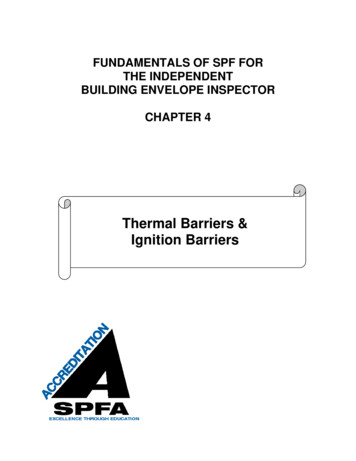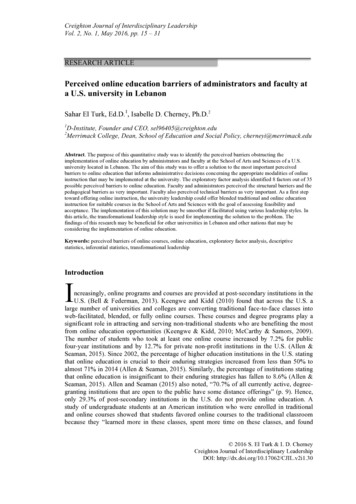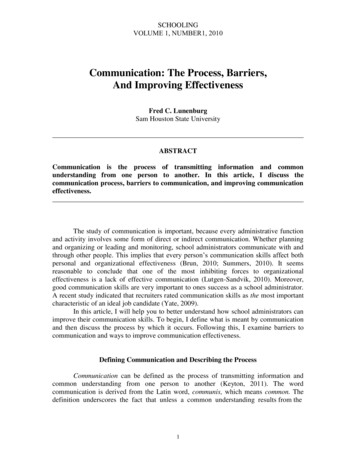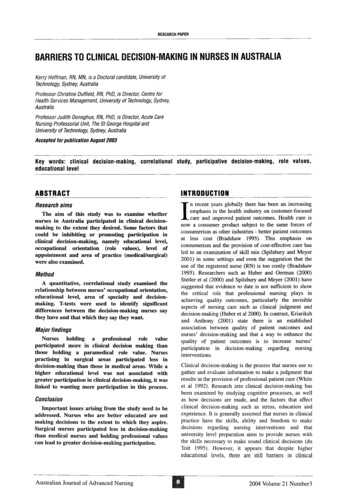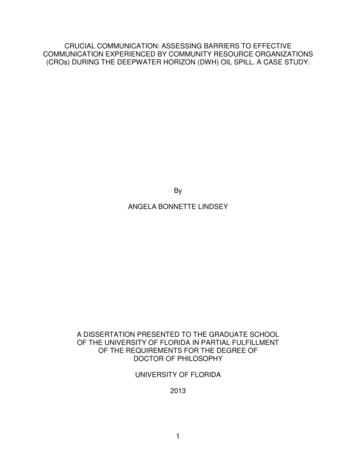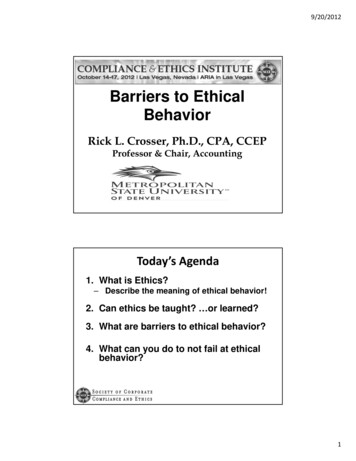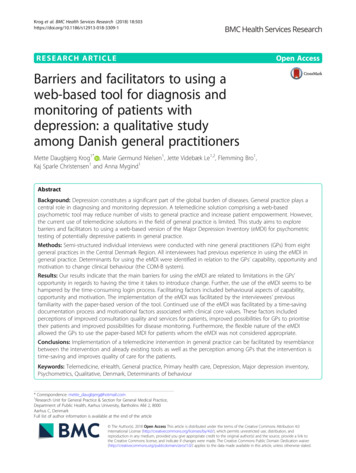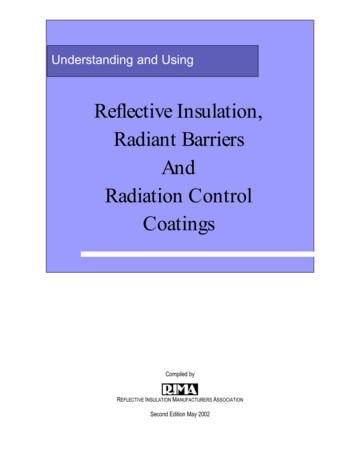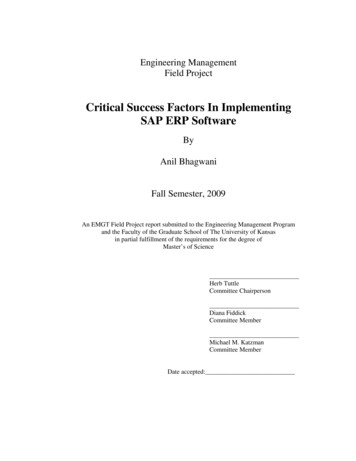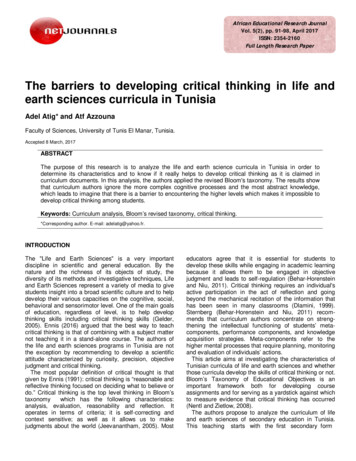
Transcription
African Educational Research JournalVol. 5(2), pp. 91-98, April 2017ISSN: 2354-2160Full Length Research PaperThe barriers to developing critical thinking in life andearth sciences curricula in TunisiaAdel Atig* and Atf AzzounaFaculty of Sciences, University of Tunis El Manar, Tunisia.Accepted 8 March, 2017ABSTRACTThe purpose of this research is to analyze the life and earth science curricula in Tunisia in order todetermine its characteristics and to know if it really helps to develop critical thinking as it is claimed incurriculum documents. In this analysis, the authors applied the revised Bloom's taxonomy. The results showthat curriculum authors ignore the more complex cognitive processes and the most abstract knowledge,which leads to imagine that there is a barrier to encountering the higher levels which makes it impossible todevelop critical thinking among students.Keywords: Curriculum analysis, Bloom’s revised taxonomy, critical thinking.*Corresponding author. E-mail: adelatig@yahoo.fr.INTRODUCTIONThe "Life and Earth Sciences" is a very importantdiscipline in scientific and general education. By thenature and the richness of its objects of study, thediversity of its methods and investigative techniques, Lifeand Earth Sciences represent a variety of media to givestudents insight into a broad scientific culture and to helpdevelop their various capacities on the cognitive, social,behavioral and sensorimotor level. One of the main goalsof education, regardless of level, is to help developthinking skills including critical thinking skills (Gelder,2005). Ennis (2016) argued that the best way to teachcritical thinking is that of combining with a subject matternot teaching it in a stand-alone course. The authors ofthe life and earth sciences programs in Tunisia are notthe exception by recommending to develop a scientificattitude characterized by curiosity, precision, objectivejudgment and critical thinking.The most popular definition of critical thought is thatgiven by Ennis (1991): critical thinking is “reasonable andreflective thinking focused on deciding what to believe ordo.” Critical thinking is the top level thinking in Bloom’staxonomywhich has the following characteristics:analysis, evaluation, reasonability and reflection. Itoperates in terms of criteria; it is self-correcting andcontext sensitive; as well as it allows us to makejudgments about the world (Jeevanantham, 2005). Mosteducators agree that it is essential for students todevelop these skills while engaging in academic learningbecause it allows them to be engaged in objectivejudgment and leads to self-regulation (Behar-Horensteinand Niu, 2011). Critical thinking requires an individual'sactive participation in the act of reflection and goingbeyond the mechanical recitation of the information thathas been seen in many classrooms (Dlamini, 1999).Sternberg (Behar-Horenstein and Niu, 2011) recommends that curriculum authors concentrate on strengthening the intellectual functioning of students’ metacomponents, performance components, and knowledgeacquisition strategies. Meta-components refer to thehigher mental processes that require planning, monitoringand evaluation of individuals’ actions.This article aims at investigating the characteristics ofTunisian curricula of life and earth sciences and whetherthose curricula develop the skills of critical thinking or not.Bloom’s Taxonomy of Educational Objectives is animportant framework both for developing courseassignments and for serving as a yardstick against whichto measure evidence that critical thinking has occurred(Nentl and Zietlow, 2008).The authors propose to analyze the curriculum of lifeand earth sciences of secondary education in Tunisia.This teaching starts with the first secondary form
Afr Educ Res Jcommon grade three sections and ends with the fourthform that has a national examination: the baccalaureate.The teaching of life sciences and earth lasts from 1 to 4hours per week and varies by level and section.Knowledge areas covered by the discipline is relateddirectly to the human’s life, health, relationship with theenvironment, use of biological and geological resources,which gives the material a high educational value –because it is constituted by values , attitudes andbehaviors conducive to health and the environment. Toaccomplish our investigation we applied a widely usedinstrument in the analysis of curricula: the RevisedBloom's Taxonomy. By using this analysis we will try toanswer the following research questions: What are thegeneral characteristics of the Life and Earth sciences inthe Tunisian curriculum? What are the cognitive skillsrequired from learners’ levels? Does this curriculumpotentially help develop critical thinking among students?High-level cognitive processing involves makinginferences, drawing conclusions, synthesizing ideas,generating hypothesis, comparing and contrasting,finding and articulating problems, analyzing andevaluating alternatives, monitoring thinking (King, 2002).A number of researchers have recommended usingparticular instructional strategies to encourage thedevelopment of critical thinking skills and abilities, suchas explicit instruction, collaborative or cooperativelearning, modeling, and constructivist techniques (Lai,2011).92(Krathwohl, 2002). This anomaly was eliminated in therevised Taxonomy by allowing these two aspects, thenoun and verb, to form separate dimensions, the nounproviding the basis for the Knowledge dimension and theverb forming the basis for the Cognitive Processdimension (Krathwohl, 2002).The Knowledge dimension contains four instead ofthree main categories ranging from concrete to abstract(Figure 1). The fourth and new category is themetacognitive Knowledge. First, the factual knowledgerepresents the elements of information related to adiscipline; it includes the facts and terminology. Second,Conceptual knowledge is knowledge of concepts, theircharacteristics and relationships. Third, proceduralknowledge is a series of steps to accomplish a task. Andfinally, metacognitive knowledge is that an individual hasof his or her cognitive processes, strengths andweaknesses.In addition, the cognitive process dimension containssix categories ranged from low to high cognitivecomplexity (Figure 2). Three categories were renamed,the order of two was interchanged, and those retainedcategories’ names were changed to verb form(Krathwohl, 2002).Finally, the knowledge and cognitive processes can becombined as a double entry table: The taxonomy tableclassifies the objectives, activities and evaluation in aclear, precise and concise way (Krathwohl, 2002).METHODOLOGYOverview of the revised bloom’s taxonomyAnalysis ofa program can highlight the cognitivedemands on children throughout the duration of theirformal schooling (Lee et al., 2015). The most used andwell-known taxonomy in the educational settings isBloom’s taxonomy from 1956, but more taxonomies havebeen developed and revised since then (Näsström, 2009).Bloom in 1956 and an educator group developed anobjective classification system: the taxonomy ofeducational objectives. This original taxonomy consists ofthree respective fields: the cognitive domain, the affectivedomain and psychomotor domain (Bloom et al., 1956).The cognitive domain consists of six categories rangingfrom simple to complex: knowledge, comprehension,application, analysis, synthesis and evaluation. Thistaxonomy had permeated teaching and instructionalplanning for almost 50 years but it was criticized by LorinAnderson, Krathwohl and a group of educationalpsychologists and educators (Anderson and Krathwohl,2001). This taxonomy has an anomaly which is theunidimensionality. In fact, the Knowledge categoryembodied both noun and verb aspects. The noun orsubject matter aspect was specified in Knowledge’sextensive subcategories. The verb aspect was includedin the definition given to Knowledge in that the studentwas expected to be able to recall or recognize knowledgeThe learning objectives covered by this analysis are the explicitgoals drafted by the Directorate of Educational Instructors &Standards from Cycle Preparatory and Secondary Education aspart of the curriculum from September 2009. The classification ofthe specific objectives was carried out by our team of fiveresearchers in science and life education. These researchers weretrained on the original and the revised taxonomy.In a first step each participant classifies the objectives that areoffered to him/her alone. Then, in a collective presentation andfollowing discussions we are agreed on the right category. Ingeneral, there is no conflict to report in the categorization that candistort the results of the research.These objectives were, in first, classified according to the Bloomfield of taxonomy in the cognitive domain, affective or psychomotor.Secondly, we were interested in the cognitive field goals that aremost important in our research. Each goal is represented in twodimensions: the dimension of knowledge form as the vertical axis ofthe taxonomic table and the dimension of the cognitive process asthe horizontal axis. The intersections of the categories ofknowledge and cognitive processes would form the cells.To see how this investment objective is accomplished, considerthe following examples taken from the life science and the earthcurriculum in 2009:Example 1Objective 1 (O1): Identify ovarian structures and stages offolliculogenesis and oogenesis.This objective is in fact formed by three sub goals:
Atig and AzzounaA. FactualKnowledge Aa. Knowledge ofterminology Ab. Knowledge ofspecific details andelementsB. ConceptualKnowledgeC. ProceduralKnowledge Ba. Knowledge ofclassifications andcategories Bb. Knowledge ofprinciples andgeneralizations Bc. Knowledge oftheories, models, andstructures93D. MetacognitiveKnowledge Ca. Knowledge of Da. Strategic knowledgesubject-specific skills and Db. Knowledge aboutalgorithmscognitive tasks, including Cb. Knowledge ofappropriate contextualsubject-specificand conditionaltechniques and methodsknowledge Cc. Knowledge of Dc. Self-knowledgecriteria for determiningwhen to use appropriateproceduresFigure 1. The Knowledge dimension from concrete to abstract. Source: Adapted from Krathwohl (2002).6.0 Create: 6.1 Generating; 6.2 Planning; 6.3 Producing5.0 Evaluate4.0 Analyze: 5.1 Checking; 5.2 Critiquing: 4.1 Differentiating; 4.2 Organizing; 4.3Attributing3.0 Apply : 3.1 Executing; 3.2 Implementing2.0 Understand : 2.1 Interpreting; 2.2 Exemplifying; 2.3Classifying; 2.4 Summarizing; 2.5 Inferring; 2.6 Comparing; 2.7Explaining1.0 Remember : 1.1 Recognizing ; 1.2 RecallingFigure 2. Structure of the Cognitive Process Dimension of the RevisedTaxonomy from less complex to high complex. Source: Adapted from Krathwohl(2002).i) Objective 1a. (O1A): Identify ovarian structuresii) Objective 1b. (O1b): Identify the steps of the folliculogensisiii) Objective 1c. (O1C): Identify the steps of oogenesisTo classify the objective according to the dimension of the cognitiveprocess we raised the action verb identify which in this case meanslocating knowledge in long-term memory That Is consistent withmaterial presented. This verb belongs to 1.0. Remember categoryand sub category 1.1. Recognize. To classify the objective that thedimension of knowledge: ovarian structures ranks in Bc. Knowledgeof theories, models, and structures which is a sub category of B.Conceptual Knowledge. However, steps in folliculogensis oroogenesis belong to another category under Ba. Knowledge ofclassifications and categoriesExample 2Objective (O2): Explain how the relief is represented on atopographic map.The verb in this case is explained. It is classified in the second
Afr Educ Res J94Table 1. The classification in a taxonomy table of the two objectives of Tunisian curriculum.1.11.22.12.22.32.4Cognitive process level2.6 2.7 3.1 3.2 4.12.54.24.35.15.26.16.26.3Aa.Ab.Knowledge 40Sciences sectionCognitive domain0Maths sectionAffective domain70Arts sectionPsychomotor domainFigure 3. Number of specific objectives identified in the Tunisian official programsof different sections.category of the dimension of the cognitive process that is 2.0Understand and subcategories 2.7 explaining and the dimension ofknowledge belongs to C. Procedural Knowledge and exactly Cb.Knowledge of subject-specific and technical methods.So we can draw the taxonomy table as shown in Table 1. Aftercompleting the classification of all objectives, the percentage isdetermined for each table cell in the three sections studied.RESULTSIn Tunisian curricula, the learning objectives are morenumerous in science section (n 83) compared to thosein the math section (n 66) and those in the arts section(n 53). This may be due to the difference in theschedules of the life and earth sciences in the course.The learning objectives in the cognitive domain arerecommended in the high school program at the expenseof the affective goals that have few mentioned (Figure 3).We note that curriculum authors claim to developsensorimotor skills (manipulative skills, handling ofinstruments of observation and measurement, drawing.). However, in the recommendations they completelyignore such goals.Knowledge areas covered by the discipline (biology,geology) relate directly to human life, its health, itsrelationship with the environment and the use ofbiological and geological resources. This means theeducational material consists of values, attitudes andbehavior favorable to health and the environment.Curriculum analysis of three sections shows thatcurriculum authors have used 18 action verbs to developthe objectives of the cognitive domain (Table 2). Theseaction verbs are unevenly distributed between firstsections and levels of learning. We note that the actionverbs are the same in the first level in the differentsections analyzed. Typically, curriculum authors have
Atig and Azzouna95Table 2. Ac
The barriers to developing critical thinking in life and earth sciences curricula in Tunisia Adel Atig* and Atf Azzouna Faculty of Sciences, University of Tunis El Manar, Tunisia. Accepted 8 March, 2017 ABSTRACT The purpose of this research is to analyze the life and earth science curricula in Tunisia in order to
